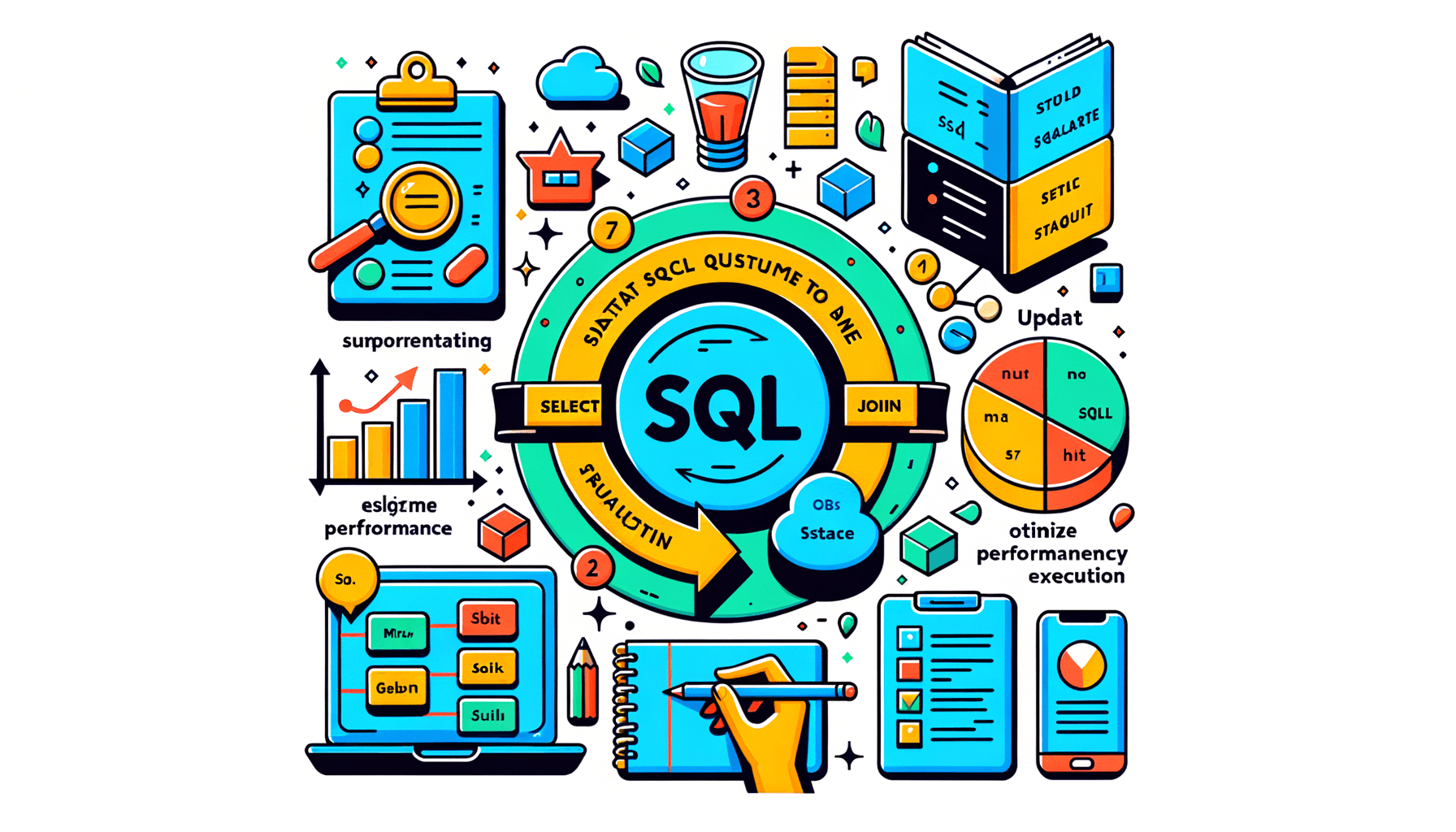A big variety of articles and resources

Unlocking the Power of Column Databases: A Comprehensive Guide
 Sia Author and Instructor
Learn SQL
Sia Author and Instructor
Learn SQL
13 minute read
Column databases are transforming how data is stored and accessed. Unlike traditional row-oriented databases, column databases store data by columns. This unique approach speeds up data retrieval and enhances performance, especially for analytical queries. Our guide will walk you through everything you need to know about column databases, from their architecture to their real-world applications.
Key Takeaways
- Column databases store data by columns rather than rows, which speeds up data retrieval.
- They are particularly useful for analytical queries and large datasets.
- Data compression and indexing strategies are crucial for optimizing column database performance.
- Column databases offer scalability and flexibility, making them suitable for cloud environments.
- Security and compliance are essential considerations in managing column databases.
Understanding Column Databases
Definition and Characteristics
Column databases, also known as columnar databases, store data in columns rather than rows. This structure allows for faster data retrieval and better storage efficiency. Column databases excel in handling large datasets, making them ideal for real-time analytics and data warehousing. They are particularly effective for read-heavy operations, where the need to access specific columns is frequent.
Historical Context and Evolution
The concept of columnar storage dates back to the 1970s, but it gained significant traction in the 2000s with the rise of big data. Traditional row-oriented databases struggled with the volume, velocity, and variety of modern data. Column databases emerged as a solution, offering improved performance for analytical queries and data compression techniques that reduce storage costs.
Comparison with Row-Oriented Databases
While row-oriented databases store data in rows, making them suitable for transactional systems, column databases store data in columns, optimizing them for analytical processing. The key difference lies in their data access patterns: row-oriented databases are efficient for write-heavy operations, whereas column databases are designed for read-heavy operations. This distinction makes column databases a powerful tool for modern data management, especially in scenarios requiring fast data retrieval and complex queries.
Architectural Foundations of Column Databases
Columnar Storage Mechanisms
Columnar storage mechanisms are the backbone of column databases. Instead of storing data by rows, these databases store data by columns. This method allows for faster data retrieval and improved query performance. Columnar storage is particularly effective for read-heavy operations, making it ideal for analytics and reporting tasks.
Data Compression Techniques
Data compression is crucial in column databases to save storage space and enhance performance. By compressing data, we can reduce the amount of disk I/O required, which speeds up query execution. Various compression techniques, such as run-length encoding and dictionary encoding, are commonly used.
Indexing Strategies
Indexing in column databases is different from traditional row-oriented databases. Column databases often use bitmap indexes, which are highly efficient for read-heavy operations. These indexes help in quickly locating the required data, thus speeding up query performance.
Understanding the architectural foundations of column databases is essential for leveraging their full potential in data analytics and decision-making.
Performance Optimization in Column Databases
Query Execution Plans
To get the best performance from column databases, it's crucial to understand query execution plans. These plans show how the database will execute a query, helping to identify bottlenecks. Optimizing these plans can significantly speed up data retrieval.
Parallel Processing
Column databases often use parallel processing to handle large datasets. By dividing tasks into smaller chunks and processing them simultaneously, the database can achieve faster query responses. This method is especially useful for complex queries that involve multiple columns.
Caching Mechanisms
Caching is another key strategy for performance optimization. By storing frequently accessed data in a cache, the database can reduce the time it takes to retrieve this data. Effective caching mechanisms can greatly enhance the speed and efficiency of data operations.
Understanding and implementing these optimization techniques can lead to substantial improvements in the performance of column databases.
Data Modeling in Column Databases
Schema Design Principles
When designing schemas for column databases, it's crucial to focus on how data will be queried. Unlike row-oriented databases, column databases store data by columns, making them highly efficient for read-heavy operations. Understanding the query patterns can help in designing an optimal schema. For instance, grouping frequently queried columns together can reduce the number of disk I/O operations.
Normalization vs. Denormalization
In column databases, the choice between normalization and denormalization depends on the specific use case. Normalization reduces data redundancy but can lead to complex joins, which may not be efficient in a columnar setup. On the other hand, denormalization can speed up read operations by storing redundant data, thus avoiding joins. It's essential to balance these approaches based on the performance requirements.
Handling Complex Data Types
Column databases are not just limited to simple data types like integers and strings. They can handle complex data types such as JSON, XML, and even arrays. This flexibility allows for more sophisticated data modeling. However, it's important to understand how these complex types are stored and queried to make the most out of the database's capabilities.
Efficient data modeling in column databases can significantly enhance performance and scalability, making them ideal for large-scale data analytics and business intelligence applications.
Scalability and Flexibility
Horizontal and Vertical Scaling
Scaling a column database can be done in two main ways: horizontally and vertically. Horizontal scaling involves adding more machines to handle the load, while vertical scaling means upgrading the existing machine's resources. Horizontal scaling is often preferred for its ability to handle large datasets and high traffic.
Elasticity in Cloud Environments
In cloud environments, elasticity allows databases to automatically adjust resources based on demand. This means you can scale up during peak times and scale down when demand is low, optimizing costs and performance. Elasticity is crucial for businesses with fluctuating workloads.
Load Balancing Techniques
Load balancing distributes the workload evenly across multiple servers. This ensures no single server becomes a bottleneck, improving both performance and reliability. Common techniques include round-robin, least connections, and IP hash. Effective load balancing is essential for maintaining a responsive and robust database system.
Scalability and flexibility are key to managing growing data needs efficiently. By leveraging horizontal and vertical scaling, elasticity, and load balancing, businesses can ensure their databases perform optimally under varying conditions.
Security and Compliance
Data Encryption Methods
In column databases, data encryption is essential to protect sensitive information. Encrypting data ensures that even if unauthorized users gain access, they cannot read the data. Common methods include AES (Advanced Encryption Standard) and RSA (Rivest-Shamir-Adleman). These methods are widely used because they provide robust security.
Access Control Mechanisms
Access control mechanisms are crucial for maintaining data security. They help in defining who can access what data and what actions they can perform. Role-Based Access Control (RBAC) and Attribute-Based Access Control (ABAC) are popular methods. These mechanisms ensure that only authorized users can access sensitive data, thereby enhancing security.
Regulatory Compliance
Compliance with regulations like GDPR (General Data Protection Regulation) and HIPAA (Health Insurance Portability and Accountability Act) is mandatory for many organizations. These regulations require strict data protection measures. Column databases often come with built-in features to help organizations meet these compliance requirements, making them a reliable choice for data management.
Ensuring security and compliance in column databases is not just about technology; it's about building trust with users and stakeholders.
Use Cases and Applications
Business Intelligence and Analytics
Column databases are a game-changer for business intelligence and analytics. They allow for fast data retrieval, which is crucial for generating reports and dashboards. Their ability to handle large datasets efficiently makes them ideal for real-time analytics and decision-making.
Real-Time Data Processing
In scenarios where real-time data processing is essential, column databases excel. They support quick read and write operations, making them suitable for applications like fraud detection, online gaming, and live data feeds. The speed and efficiency of column databases ensure that data is processed and available almost instantly.
Data Warehousing
Column databases are often used in data warehousing due to their high compression rates and efficient storage mechanisms. They can store vast amounts of data while maintaining quick access times. This makes them perfect for historical data analysis and long-term data storage.
Column databases are not just a tool but a strategic asset in modern data management, offering unparalleled speed and efficiency for various applications.
Integration with Other Systems
ETL Processes
When working with column databases, integrating them into existing systems often involves ETL (Extract, Transform, Load) processes. These processes are essential for moving data from various sources into the column database. ETL tools help in transforming the data into a format suitable for analysis and loading it efficiently.
Interoperability with SQL and NoSQL Databases
Column databases need to work seamlessly with both SQL and NoSQL databases. This interoperability ensures that data can flow smoothly between different types of databases, allowing for more flexible data management. Using connectors and APIs, we can bridge the gap between these systems, making data integration more straightforward.
APIs and Connectors
APIs and connectors play a crucial role in integrating column databases with other systems. They provide the necessary interfaces for data exchange, ensuring that the column database can communicate effectively with other software applications. This integration is vital for creating a cohesive data ecosystem that supports various business needs.
Challenges and Limitations
Write Performance Issues
Column databases often excel in read-heavy operations but can struggle with write performance. This is because data is stored in columns rather than rows, making it less efficient for frequent updates. Optimizing write performance requires careful planning and sometimes additional hardware resources.
Complexity in Data Management
Managing data in column databases can be complex. The structure is different from traditional row-oriented databases, which can make tasks like data modeling and schema design more challenging. This complexity often necessitates specialized knowledge and tools.
Cost Considerations
While column databases can offer significant performance benefits, they can also be expensive to implement and maintain. The costs can include licensing fees, hardware upgrades, and the need for specialized personnel. It's essential to weigh these costs against the benefits to determine if a column database is the right choice for your needs.
In summary, while column databases offer many advantages, they come with their own set of challenges and limitations. Understanding these can help you make informed decisions about their use in your projects.
Future Trends in Column Databases
Advancements in Hardware
The future of column databases is closely tied to advancements in hardware. Faster processors, larger memory capacities, and improved storage technologies will enable databases to handle more data and perform complex queries more efficiently. These hardware improvements will also support better parallel processing, which is crucial for speeding up data retrieval and analysis.
AI and Machine Learning Integration
AI and machine learning are set to revolutionize column databases. By integrating these technologies, databases can become more intelligent, optimizing query execution and automating routine tasks. This will not only enhance performance but also reduce the need for manual intervention, making data management more efficient.
Evolving Standards and Protocols
As the database landscape evolves, so do the standards and protocols that govern them. New standards will emerge to address the growing needs for data security, interoperability, and compliance. These evolving standards will ensure that column databases remain relevant and capable of meeting future challenges.
The future of column databases is bright, with advancements in hardware, AI integration, and evolving standards paving the way for more efficient and intelligent data management systems.
Case Studies and Industry Examples
Successful Implementations
In the world of data management, column databases have shown remarkable success across various industries. For instance, a leading healthcare provider utilized a column database to streamline patient records, resulting in a 50% reduction in query time. This improvement not only enhanced operational efficiency but also improved patient care by providing quicker access to critical information.
Lessons Learned
From these implementations, several key lessons have emerged. One important takeaway is the need for proper schema design. Poorly designed schemas can lead to performance bottlenecks, negating the benefits of columnar storage. Additionally, it's crucial to invest in data compression techniques to maximize storage efficiency and reduce costs.
Best Practices
To ensure the success of column database projects, consider the following best practices:
- Optimize Query Execution: Ensure that queries are well-optimized to take full advantage of the columnar storage format.
- Regular Maintenance: Perform regular maintenance tasks such as updating statistics and rebuilding indexes to maintain performance.
- Scalability Planning: Plan for scalability from the outset to handle growing data volumes without compromising performance.
Column databases have proven to be a game-changer in data management, offering significant improvements in query performance and storage efficiency. By learning from successful implementations and adhering to best practices, organizations can unlock the full potential of these powerful systems.
Explore our case studies and industry examples to see how our courses have helped others succeed. From mastering SQL to diving into AI, our students have achieved amazing results. Ready to start your own success story? Visit our website to learn more and get started today!
Conclusion
In conclusion, column databases offer a powerful solution for managing and analyzing large datasets efficiently. By storing data in columns rather than rows, these databases optimize query performance and reduce storage costs. This makes them particularly useful for applications that require fast data retrieval and complex analytical queries. As data continues to grow in volume and complexity, the adoption of column databases is likely to increase, providing organizations with the tools they need to stay competitive in a data-driven world. Understanding the principles and advantages of column databases is essential for anyone involved in data management and analysis.
Frequently Asked Questions
What is a column database?
A column database stores data in columns instead of rows. This makes it faster for read-heavy tasks like data analysis.
How is a column database different from a row-oriented database?
In a row-oriented database, data is stored in rows, which is better for write-heavy tasks. Column databases store data in columns, making them better for read-heavy tasks.
Why are column databases good for data compression?
Column databases store similar data together, which makes it easier to compress. This saves space and speeds up data reading.
What are some common use cases for column databases?
Column databases are often used in business intelligence, data warehousing, and real-time data processing because they are fast at reading large amounts of data.
Can column databases handle complex data types?
Yes, many column databases can handle complex data types like JSON and XML, making them versatile for different kinds of data.
Are column databases scalable?
Yes, column databases can scale both horizontally and vertically. This means you can add more servers or more power to existing servers to handle more data.
What are the challenges of using column databases?
Column databases can be slower for write-heavy operations and more complex to manage. They can also be more expensive than row-oriented databases.
What are the future trends for column databases?
Future trends include better hardware, integration with AI and machine learning, and evolving standards to make them even more efficient and versatile.
Related Articles

Mastering the Basics: SQL for Beginners
15 minute read






